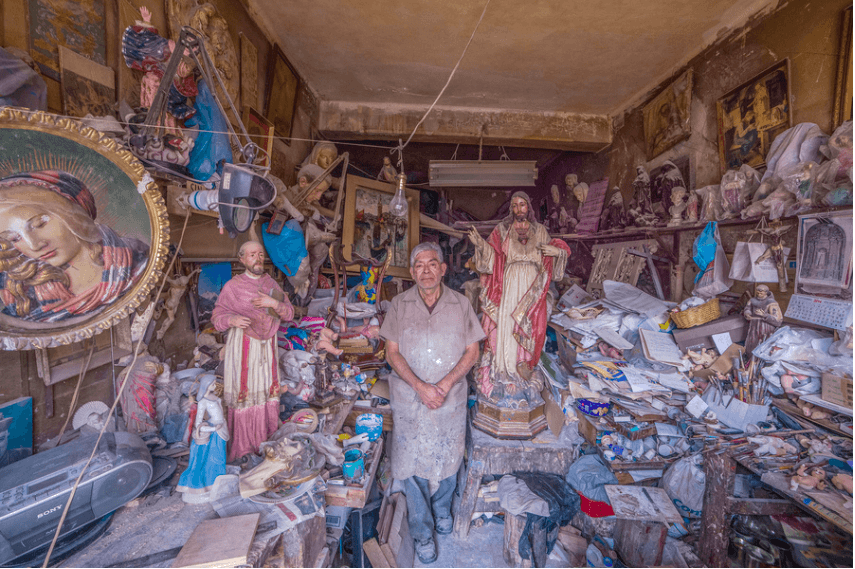Society
11.12.2019
“The Guardians”, Vladimir Antaki’s tribute to the forgotten of consumer society

Last week at Royal Monceau art bookstore, the photographer Vladimir Antaki presents “The Guardians”, a book tribute to craftsmen and shopkeepers from around the world, bringing together 45 portraits taken across Europe, America and the Middle East.
“Through his photographic survey, Antaki addresses the social value and fragile nature of individualized work in an increasingly homogenized, consumerist society…” writes the famous Canadian photographer Edward Burtynsky, in the preface of the book. This comment, made by the one who is known for his clichés exploring the impact of human intervention on natural landscapes, underlines the humanistic dimension of Vladimir Antaki work.
If inside the kitsch and colorful portraits of The guardians, the subjects seem to blend in the setting, it is always to come out more shining than ever. Through his sense of composition, Vladimir Antaki invites us to look at what tends to disappear in the crowd. In the manner of a filmmaker, he manages to sublimate the invisibles in a sort of social testimony that reminds us of Ken Loach, but brighter and more colorful.
All your photography work is very eclectic. With Elsfie, you took pictures of celebrities holding selfies of you. In Family Portrait, you capture the picture of families of refugees living in the streets of Paris. What motivates a serie for you usually?
When I start working usually, my goal is to tell a story that goes much deeper than just taking a few photographs. At one point, it becomes an obsession. For my series of the guardians, I sometimes spent 15 hours a day looking for small shops, because I was obsessed with the idea of making homogeneous places that were not. When I photographed those families on the street in Paris, the topic was terrible but I treated it like a “game” that gave me a reason to go out and get in touch with them. What motivates a series in the first place is the permanent adrenaline of creating images that relate to each other.

For your series “The guardians”, you photographed 200 people on three continents. What made you choose one person over another?
For this serie, I visited more than 20 cities in a quest of what I call “urban temples” and the people who keep them, their “Guardians” from which I took the name of the exhibition. I met people and collected their stories, people who moved me with the beauty of their backgrounds and stories. My book and photos also talk about transmission because some of them are worried about not being able to convey their know-how or shop. I spent whole days strolling through cities like Beirut, Montreal or Los Angeles, and as soon as I saw a facade that could house a potential guardian, I passed my head in and was generally received with a big smile.
Why did you choose to have Edward Burtynsky sign the preface to your book?
In 2016, I left my comfort zone in Montreal to live in Toronto. There, I was printing my photographic work in Edward Burtynsky’s laboratory, and I became friend with the director. One day, while I was losing faith in myself, I asked her if I could meet Edward and it worked out. We spent an hour together, he gave me encouraging comments about my work and offered me to take part in a portfolio reading just for a photo festival he co-founded. A few days later, I left Toronto for Beirut where I settled for 8 months. Then, a year ago, I met him again at Paris Photo and I asked him to do my preface. He accepted, which is an honor for me because he is a person I admire on every aspect.

You attend the 3rd edition of the contemporary Arab Photographs Biennale at the Arab World Institute in Paris, with the serie “Beyrouth mon amour”. What was the idea behind those urban frescoes?
Beyrouth mon amour is a kind of Trojan horse because it is a work that looks like a pretty wallpaper on the surface, but requires a deeper interest in the visual to be able to understand the message behind it. I was tired of seeing a certain Lebanese bourgeoisie trying to preserve the image of Beirut, and to try to erase what it is really. The city is very nice like it is and that’s why I decided to photograph both old buildings in poor neighborhoods and fancy ones in richer areas, Christian or Muslim. The idea was to create a motif that reminds of oriental mosaics and that people want to own, bringing home a piece of a neighborhood in which they would never go usually. To do something aesthetic with what is not.
I’ve read on your instagram page that until recently you tried to identify yourself as little as possible in Lebanon. How have the demonstrations managed to change that?
Lebanese have a lot of positives. They are generous, they like to give service and to please. But there are also a lot of clichés around them like saying they like to party as if everything could stop tomorrow. As if everything could be justified by that. I do not identify with this idea and I wanted to detach myself for a long time, but when I saw the generosity of generosity coming from all sides of society during the demonstrations, this desire to make things happen, I was proud of my people.

popular

